Popups are a versatile tool that can be used to enhance user experience, gather feedback, and promote engagement on educational websites. They are small windows that appear on a website, often triggered by specific user actions or timed events, and can deliver targeted messages, offers, or requests for information.
In the realm of digital education, popups are more than just a tool—they are a bridge to enhanced engagement and improved user experience.
Importance of Popups for Educational Websites
Educational websites can greatly benefit from the strategic use of popups. These benefits include:
Enhanced User Engagement: Popups can prompt users to take specific actions, such as signing up for a newsletter, attending a webinar, or participating in a survey.
Increased Conversions: By highlighting key information or offers, popups can drive more sign-ups for courses or other educational content.
Feedback Collection: Popups are an effective way to gather feedback from users, which can be used to improve the website and its offerings.
Information Dissemination: Popups can quickly inform users about important updates, events, or deadlines.
4 Types of Popups for Educational Websites
1. Informational Popups
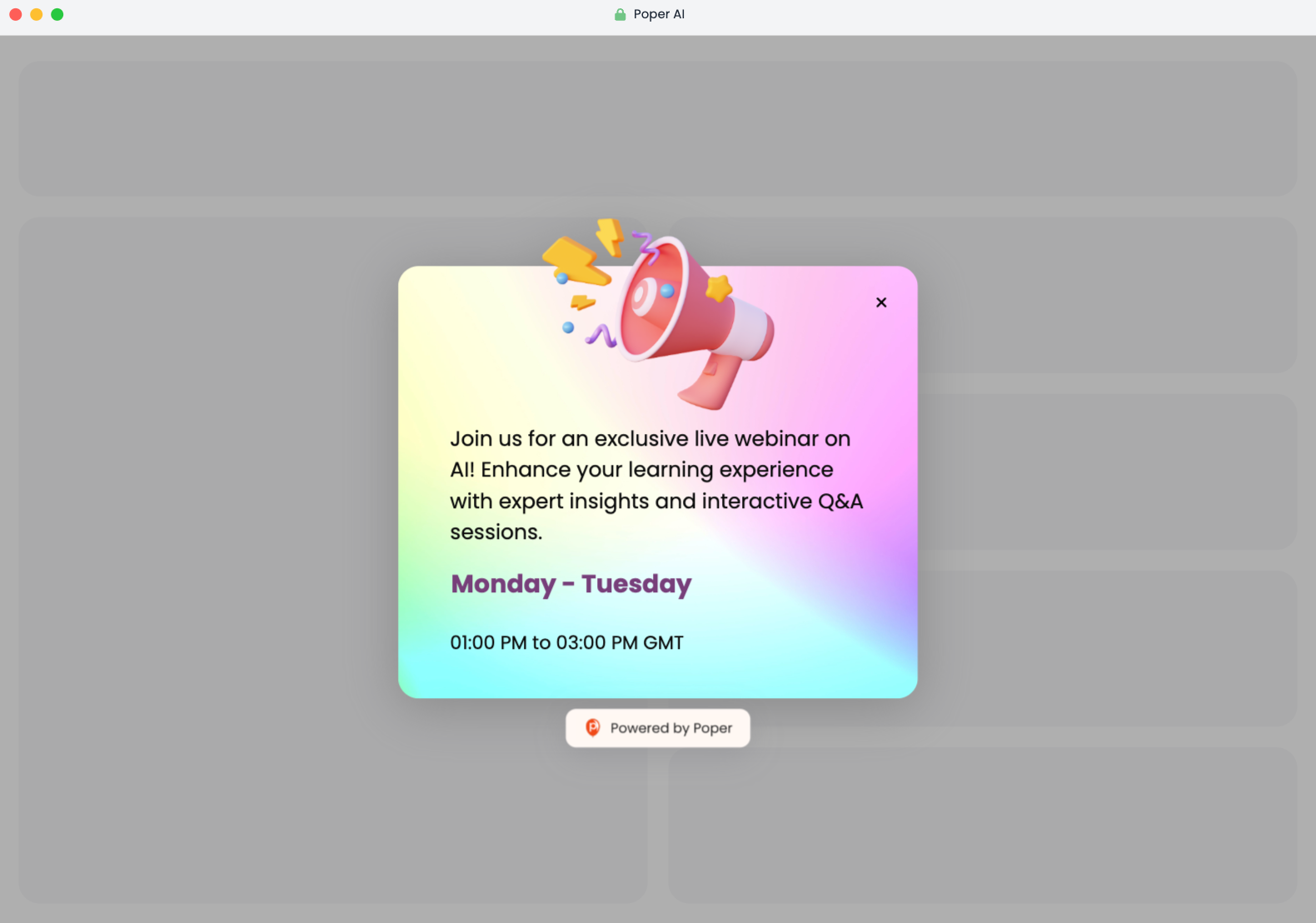
Announcements
Informational popups are ideal for sharing important announcements with your audience. These can include updates about new courses, changes to the curriculum, or important institutional news.
Event Reminders
Use popups to remind students and visitors about upcoming events such as webinars, guest lectures, or enrollment deadlines. This ensures that important dates are not missed and helps increase participation.
2. Interactive Popups
Quizzes and Surveys
Interactive popups, such as quizzes and surveys, engage students actively. They can be used to test knowledge, gather opinions, or conduct quick polls on various topics.
Polls and Feedback Forms
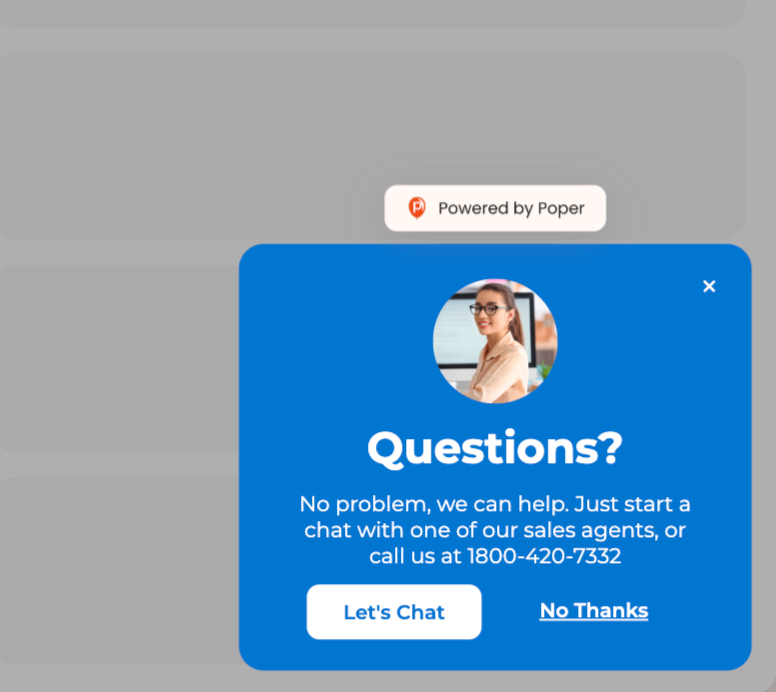
Popups can be utilized to collect feedback through polls and forms. This feedback can be invaluable for understanding user needs and improving the website or educational offerings.
3. Promotional Popups
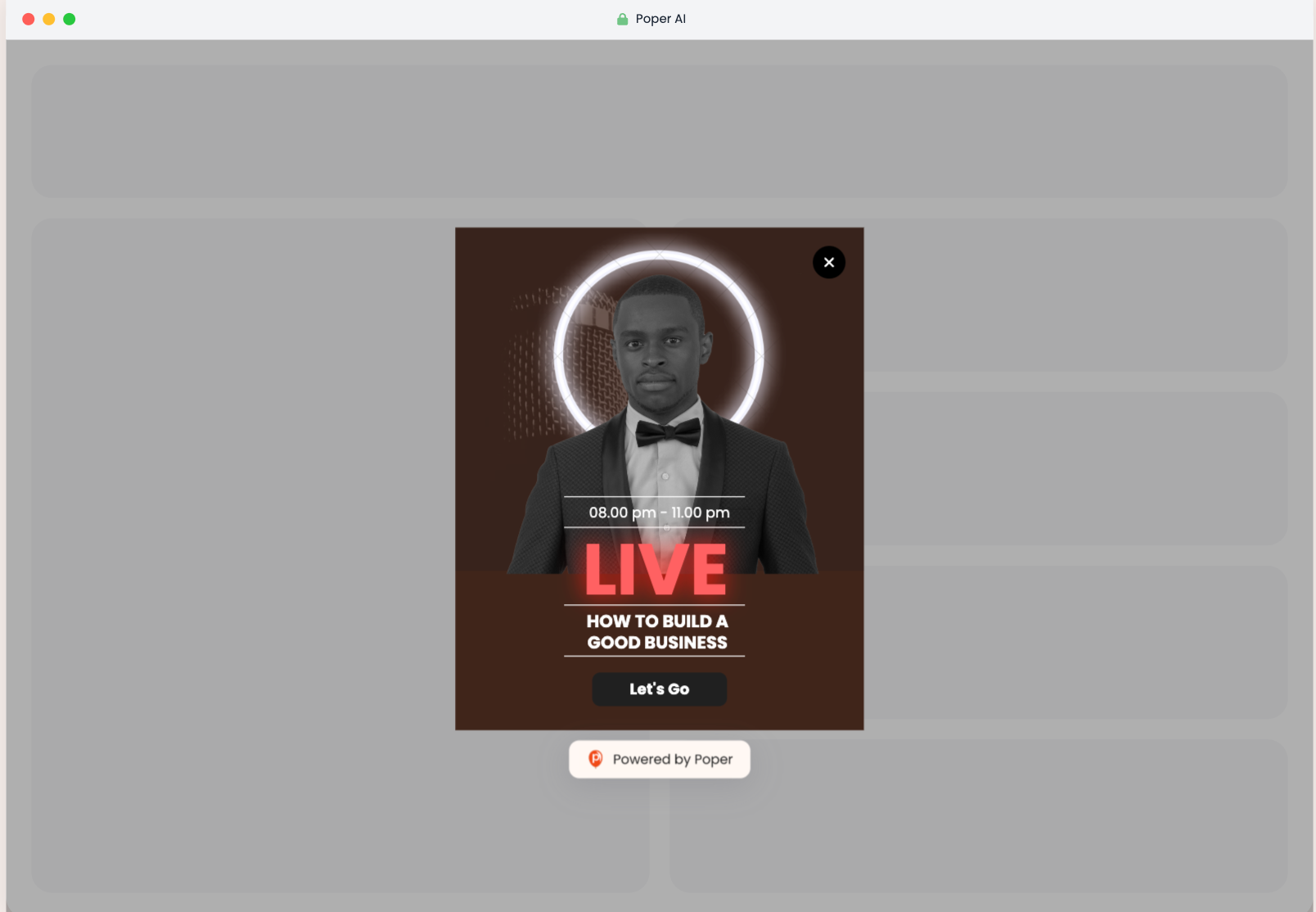
Course Enrollment Prompts
Promotional popups are effective for driving course enrollments. Highlight the benefits of a course and provide a clear call-to-action to encourage sign-ups.
Special Offers and Discounts
Use popups to promote special offers or discounts on courses, workshops, or educational materials. This can incentivize visitors to take immediate action.
4. Engagement Popups
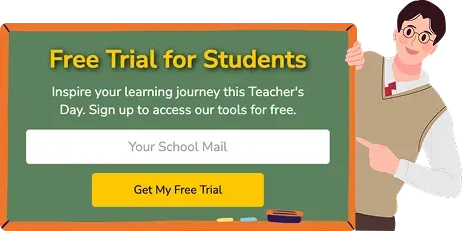
Welcome Messages
Welcome messages can greet new visitors to your site, providing them with a brief introduction and guiding them towards key areas of the website.
Exit-Intent Popups
Exit-intent popups appear when a user is about to leave the site. They can be used to retain users by offering last-minute deals, asking for feedback, or providing additional resources.
Planning Your Popup Strategy

Setting Clear Objectives
Goals for Using Popups
Before implementing popups, it's essential to define clear goals. These might include increasing course enrollments, boosting newsletter subscriptions, collecting user feedback, or promoting upcoming events.
Aligning Popups with Educational Objectives
Ensure that each popup aligns with your broader educational objectives. For example, a popup promoting a webinar should clearly relate to the curriculum or educational mission of your institution.
Identifying Target Audience
Segmenting Users Based on Their Interaction with the Site
Understanding who your audience is and how they interact with your site can help tailor your popups. Segment users based on their behavior, such as pages visited, time spent on the site, or actions taken.
Tailoring Popups to Different User Groups
Customize popups to address the specific needs of different user groups. For instance, prospective students might see popups about admissions, while current students might receive reminders about deadlines or events.
Designing Effective Popups
Crafting Compelling Headlines and CTAs
Importance of Clear and Engaging Headlines

The headline is the first thing users see, so it needs to grab their attention and convey the value of the popup quickly. A compelling headline can make the difference between a user engaging with your popup or closing it immediately.
Examples:
"Join Our Free Webinar on Advanced Mathematics!"
"Sign Up for Exclusive Course Discounts Today!"
"Complete This Quick Survey and Help Us Improve!"
Creating Strong Call-to-Actions
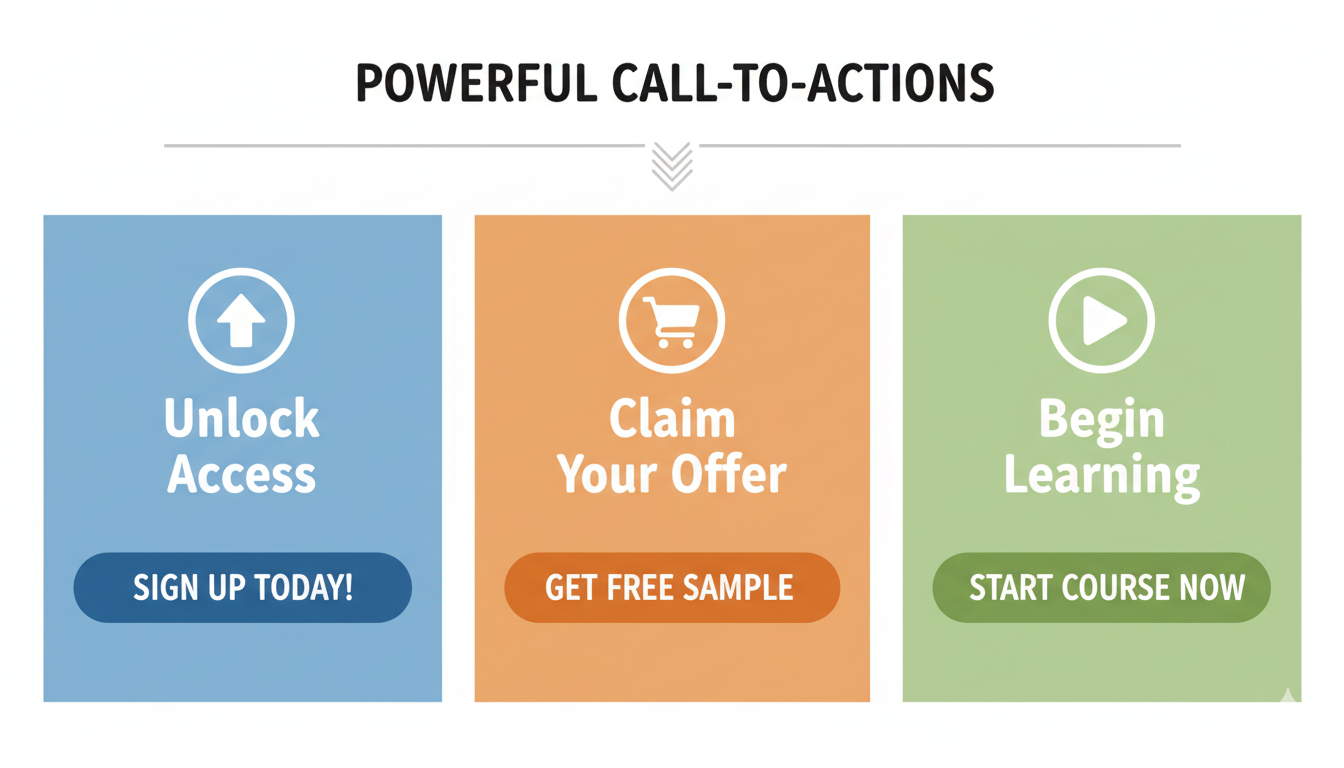
A call-to-action (CTA) should be clear, concise, and encourage immediate action. It should tell users exactly what you want them to do next.
Examples:
"Register Now"
"Get Your Discount"
"Start the Quiz"
Visual Design Best Practices
Choosing Appropriate Colors, Fonts, and Images
The design of your popup should align with your website’s overall aesthetic while standing out enough to catch the user’s eye. Use contrasting colors for buttons, readable fonts, and relevant images to enhance the message.
Tips:
Use high-contrast colors to make CTAs stand out.
Select fonts that are easy to read across all devices.
Include images or icons that support the popup’s content.
Ensuring Accessibility and Readability
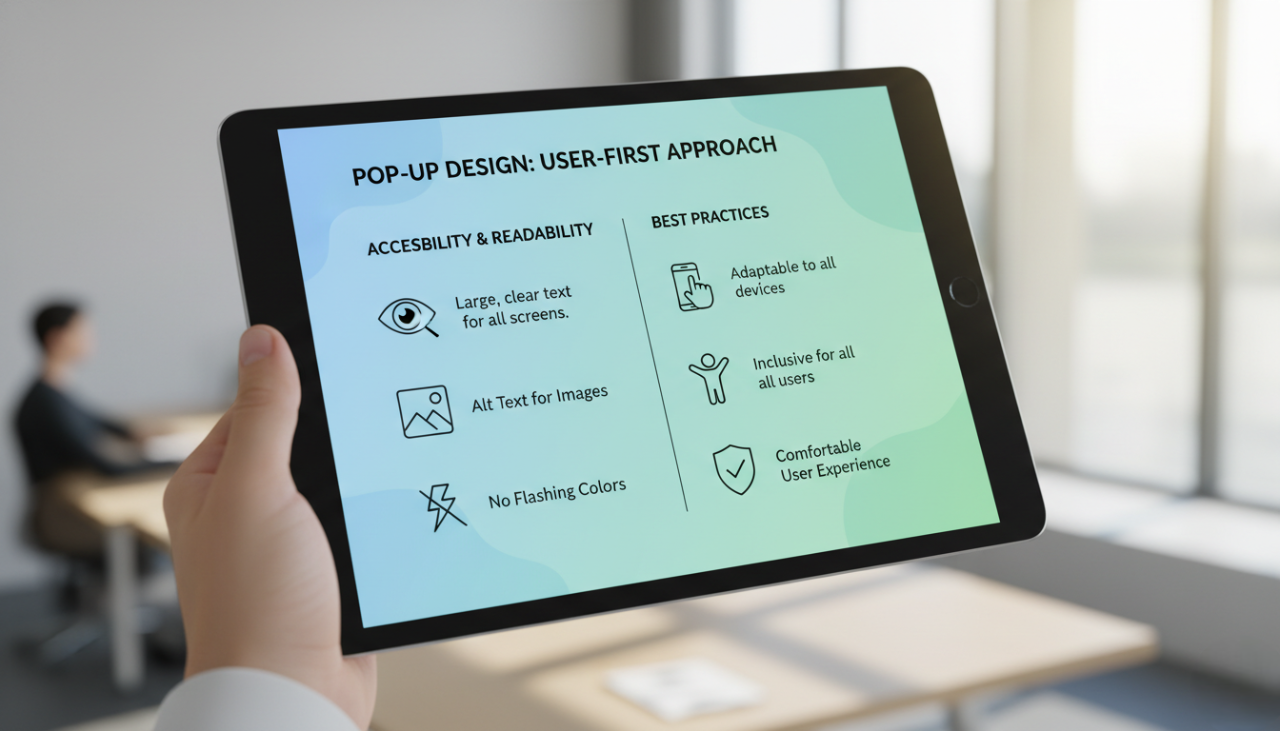
Accessibility should be a priority in your design to ensure all users, including those with disabilities, can interact with your popups.
Best Practices:
Ensure text is large enough to read on all devices.
Use alt text for images.
Avoid overly bright or flashing colors that could cause discomfort.
Writing Engaging Popup Content
Tips for Concise and Persuasive Messaging
The content of your popup should be concise yet persuasive, providing users with clear and compelling reasons to take action.
Strategies:
Keep sentences short and to the point.
Highlight the benefits of taking action.
Use bullet points to break down information.
Incorporating Educational Value

Ensure that the content of your popups adds value to the user’s educational experience. This could be by providing useful information, offering resources, or highlighting important updates.
Examples:
"Sign up to access our free library of study materials."
"Join our newsletter for the latest research updates."
Popup Placement and Timing

Strategic Placement for Maximum Impact
Where to Place Popups on the Website
The placement of your popups can significantly impact their effectiveness. Strategic placement ensures that popups appear where they are most likely to be noticed and acted upon.
Best Locations:
Home page: Welcome messages or introductory offers.
Course pages: Enrollment prompts and course details.
Blog posts: Subscription prompts or related content offers.
Avoiding Intrusive Placements
While popups are effective, they can also be disruptive if not placed thoughtfully. Avoid placing popups in ways that interrupt the user’s experience or obscure important content.
Tips:
Avoid popups that cover critical information.
Ensure users can easily close or dismiss the popup.
Optimal Timing and Triggers
Best Times to Display Popups
Timing is crucial for popup effectiveness. Display popups when users are most likely to engage with them.
Optimal Timings:
On entry: Welcome messages and introductory offers.
Mid-session: After a user has spent some time on the page.
On exit: Exit-intent popups to retain users.
Using Behavioral Triggers Effectively
Behavioral triggers can enhance the relevance of your popups by displaying them based on specific user actions.
Examples of Behavioral Triggers:
Scroll depth: Display popups when a user scrolls to a certain point.
Time on page: Show popups after a user has spent a set amount of time on the page.
Exit intent: Trigger popups when a user is about to leave the site.
Engaging Students with Interactive Popups

Quizzes and Surveys
Designing Educational Quizzes
Quizzes are a great way to engage students and assess their understanding of the material. Popups can be used to present short, interactive quizzes that test knowledge and reinforce learning.
Best Practices:
Keep quizzes short and focused on key concepts.
Use a mix of question types (multiple choice, true/false, short answer).
Provide immediate feedback to reinforce learning.
Collecting and Utilizing Survey Data
Surveys can gather valuable feedback from students about their learning experience, course content, and website usability. Use popup surveys to capture this information efficiently.
Tips:
Ask clear, concise questions.
Use rating scales and open-ended questions for detailed feedback.
Analyze survey data to identify areas for improvement.
Polls and Feedback Forms
Creating Engaging Polls
Polls are a quick and interactive way to gather opinions from students on various topics. Popups can be used to present polls that are easy to complete and provide instant results.
Examples:
"Which topic should we cover next?"
"How do you rate your experience with this course?"
Encouraging Student Feedback
Feedback forms are essential for understanding student needs and improving the educational offering. Use popups to prompt students to provide feedback on their experience.
Strategies:
Make feedback forms simple and quick to complete.
Offer incentives for providing feedback, such as entry into a prize draw.
Show appreciation for feedback by sharing how it will be used to make improvements.
Enhancing Course Enrollment with Popups
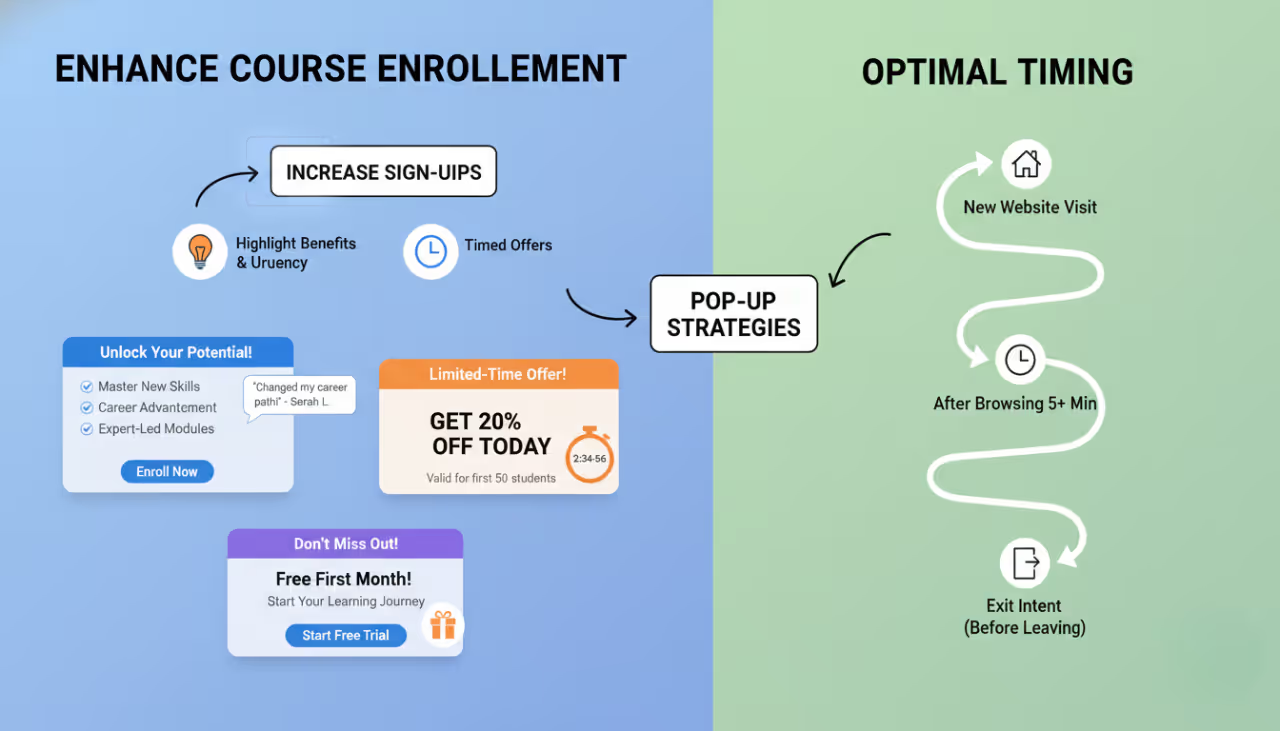
Enrollment Prompts
Strategies to Increase Course Sign-Ups
Popups can be highly effective in promoting course enrollments by highlighting the benefits and creating a sense of urgency.
Best Practices:
Use clear, compelling headlines that convey the value of the course.
Highlight key benefits and features of the course.
Include a strong call-to-action, such as "Enroll Now" or "Start Your Free Trial."
Highlighting Course Benefits
Ensure that the popup clearly communicates the advantages of enrolling in the course. This could include course outcomes, skills gained, and testimonials from past students.
Tips:
Use bullet points to list key benefits.
Include quotes or testimonials from satisfied students.
Add visual elements like icons or images to make the popup more appealing.
Special Offers and Discounts
Designing Promotional Popups
Promotional popups can drive enrollments by offering special discounts or limited-time offers. These popups should create a sense of urgency and highlight the value of the offer.
Examples:
"Enroll Today and Get 20% Off!"
"Limited Time Offer: Free First Month!"
Timing Promotions for Maximum Effect
The timing of promotional popups is crucial to their success. Display these popups at strategic points in the user journey to maximize their impact.
Best Times:
When a user first visits the course page.
After a user has spent a significant amount of time browsing the site.
On exit intent, to capture users who are about to leave.
Using Popups for Event Promotion

Event Announcements
Promoting Upcoming Events and Webinars
Popups can be used to announce and promote upcoming events, such as webinars, guest lectures, or workshops. These popups should provide key details and encourage users to register or attend.
Best Practices:
Include the event title, date, time, and a brief description.
Use a strong call-to-action, such as "Register Now" or "Join Us Live."
Add a countdown timer to create a sense of urgency.
Using Countdown Timers
Countdown timers can increase engagement by creating a sense of urgency and reminding users of the approaching event.
Tips:
Place the timer prominently within the popup.
Ensure the timer is accurate and updates in real-time.
Use contrasting colors to make the timer stand out.
Reminder Popups
Sending Reminders for Events and Deadlines
Reminder popups are a great way to ensure that students and visitors do not forget important events or deadlines. These popups should be timely and include all necessary information.
Examples:
"Don't Forget: Webinar Starting in 1 Hour!"
"Reminder: Assignment Due Tomorrow!"
Ensuring Timely Notifications
The timing of reminder popups is crucial to their effectiveness. Ensure that reminders are sent at appropriate intervals leading up to the event or deadline.
Best Practices:
Send initial reminders a few days before the event or deadline.
Follow up with additional reminders as the date approaches.
Include options for users to add the event to their calendar.
Gathering Feedback through Popups

Creating Effective Feedback Forms
Designing User-Friendly Feedback Forms
Feedback forms in popups are a great way to gather insights from students and visitors. To maximize response rates, these forms should be user-friendly and straightforward.
Best Practices:
Keep the form short and focused on key questions.
Use a mix of question types (multiple choice, rating scales, open-ended).
Ensure the form is mobile-friendly and easy to complete on all devices.
Analyzing and Utilizing Feedback Data
Once feedback is collected, it’s essential to analyze the data and use it to make informed decisions. This can help improve the website, course content, and overall user experience.
Steps for Analysis:
Categorize feedback into themes or topics.
Identify common issues or suggestions.
Use data visualization tools to highlight key insights.
Improving User Experience
Using Feedback to Enhance Website Usability
Feedback collected through popups can highlight areas where the website's usability can be improved. Use this feedback to make targeted changes that enhance the user experience.
Examples:
Simplifying navigation based on user suggestions.
Improving page load times where users report slow performance.
Enhancing mobile responsiveness in response to user feedback.
Implementing Changes Based on Feedback
After analyzing feedback, implement changes and communicate these improvements to your users. This shows that you value their input and are committed to providing a better experience.
Best Practices:
Prioritize changes that have the most significant impact on user satisfaction.
Roll out updates in stages and monitor user response.
Inform users of changes through announcements or follow-up popups.
How to Create a Popup for an Educational Website Using Poper
Creating popups for your educational website using Poper is a straightforward process that can significantly enhance user engagement and conversions. Here’s a step-by-step guide to help you create impactful popups with Poper.
Step 1: Sign Up and Set Up Your Account
Before you start creating popups, you need to sign up for a Poper account and set up your dashboard.

Sign Up: Visit the Poper website and sign up for an account by providing the necessary details about your educational website.
Set Up Dashboard: Once your account is created, navigate to your dashboard where you can manage all your popups and click "New Popup"
Step 2: Choose the Type of Popup
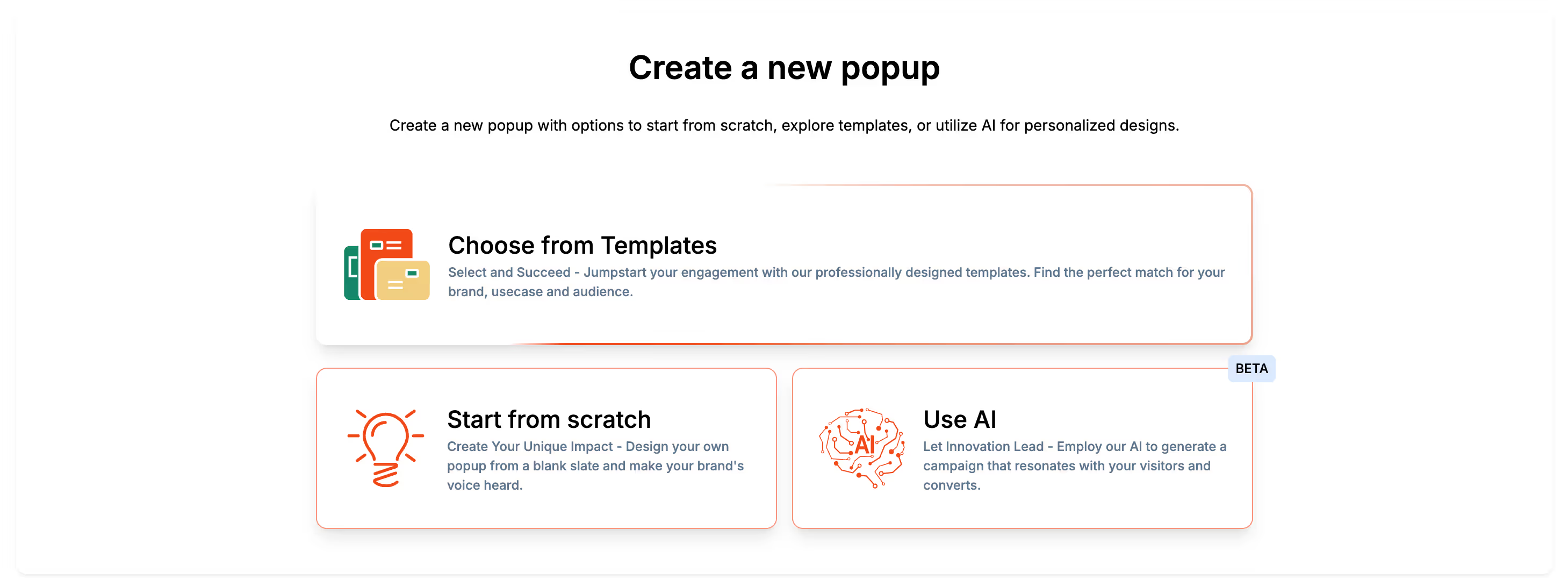
Poper offers various types of popups to suit different purposes. Choose the one that aligns with your specific goals.
Select from Templates: Click on Create a Popup and select Choose a Template. Poper provides professionally designed templates that can be customized to fit your brand and objectives. Choose a template that matches your campaign, whether it’s for course enrollments, feedback, or event promotions.
Start from Scratch: If you prefer complete control over the design, you can start from scratch and build your popup from the ground up.
Use AI-Generated Designs: Poper’s AI feature can generate personalized popup designs based on your inputs, saving you time and ensuring high relevance.
Step 3: Customize Your Popup

Customization is key to making your popups stand out and resonate with your audience.
Design: Use Poper’s drag-and-drop builder to customize your popup. Adjust colors, fonts, images, and layout to match your brand’s identity. Ensure that the design is visually appealing and consistent with your overall aesthetic.
Content: Write clear and compelling content. The headline should be attention-grabbing, and the call-to-action (CTA) should be persuasive and direct. For example, “Sign Up for Our Webinar!” or “Get Your Course Discount Now!”.
Timing and Triggers: Set up triggers to control when and how your popup appears. Options include time on page, scroll depth, exit intent, and specific user actions. This ensures that your popup appears at the most opportune moments.
Step 4: Apply AI and Audience Filtering
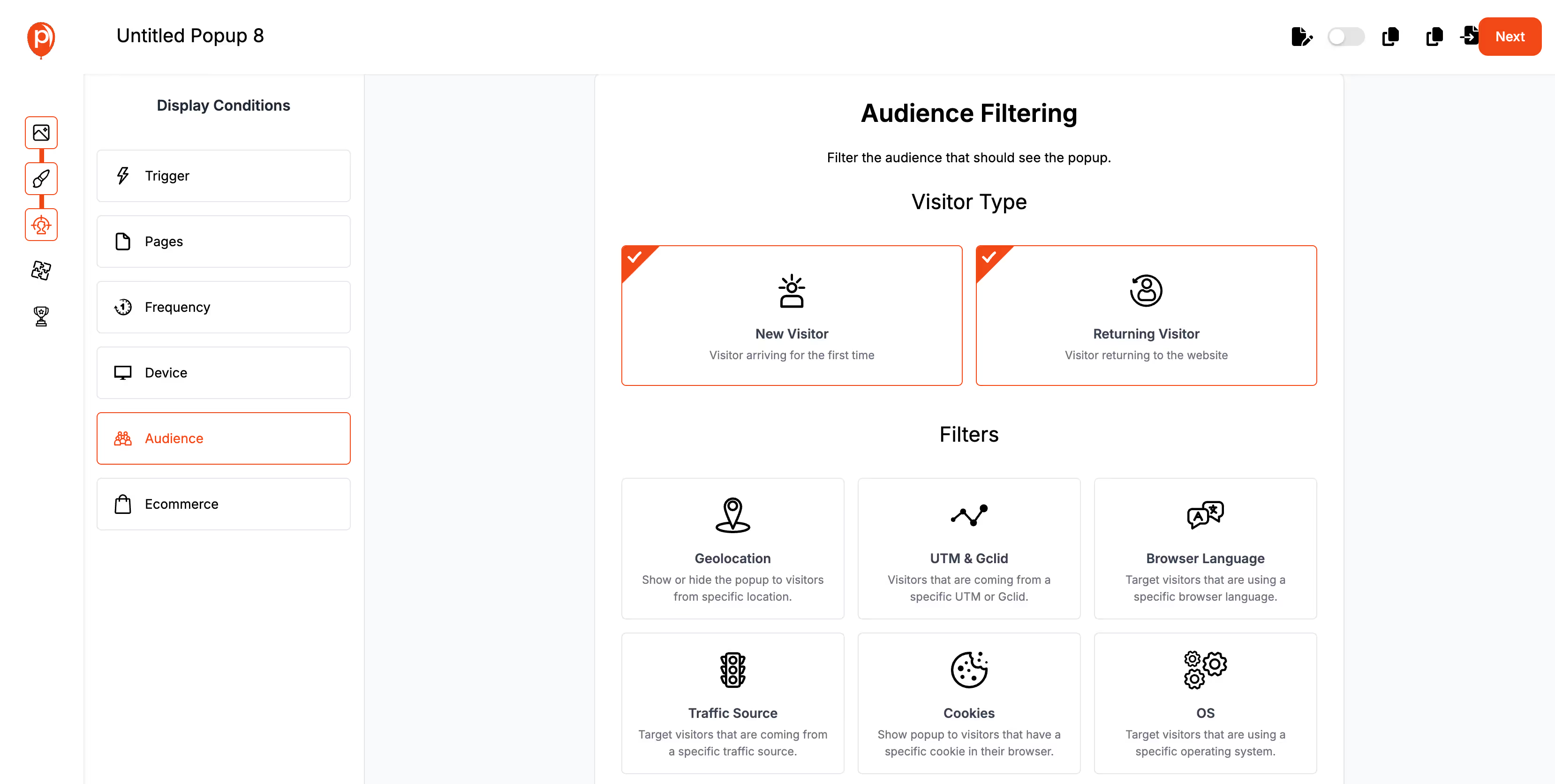
Poper’s AI and audience filtering features allow you to target your popups more effectively.
Use AI for Dynamic Content: Enable AI to dynamically adjust content based on user behavior and preferences. For example, show different messages to new visitors versus returning students.
Audience Filtering: Segment your audience to display specific popups to different user groups. For instance, offer a discount to first-time visitors and a loyalty reward to returning students.
Step 5: Integrate and Publish
Seamless integration ensures your popups enhance the user experience without disrupting it.
Embed the Popup Code: Follow Poper’s integration instructions to embed the popup code into your educational website. This is straightforward for most CMS platforms like WordPress.
Save and Publish: Once everything is set up and tested, click “Save & Publish” to make your popup live. Ensure you test the popup on different devices and browsers to confirm it functions correctly.
Step 6: Monitor and Optimize
Continuous monitoring and optimization are crucial for the success of your popups.
Use Poper’s Analytics: Track key metrics such as impressions, click-through rates (CTR), and conversion rates using Poper’s built-in analytics tools. This data helps you understand how well your popups are performing.
Conduct A/B Testing: Run A/B tests to compare different versions of your popups. Experiment with variations in headlines, CTAs, designs, and timing to determine what works best.
Iterate Based on Feedback: Use the insights gathered from analytics and A/B testing to make iterative improvements to your popups. This ensures they remain effective and relevant to your audience.
Analyzing and Optimizing Popup Performance

Tracking Key Metrics
Important Metrics to Monitor
To assess the effectiveness of your popups, it’s crucial to track key performance metrics. These metrics provide insights into how users are interacting with your popups and their impact on your goals.
Key Metrics:
Impressions: The number of times a popup is displayed.
Click-Through Rate (CTR): The percentage of users who click on the popup.
Conversion Rate: The percentage of users who complete the desired action (e.g., sign up, provide feedback).
Exit Rate: The percentage of users who close the popup without interacting.
Tools for Tracking Popup Performance
There are various tools available to help track and analyze the performance of your popups. These tools can provide detailed analytics and insights.
Recommended Tools:
Google Analytics
Poper's built-in analytics
Heatmap tools like Hotjar
Conducting A/B Testing
Setting Up A/B Tests for Popups
A/B testing involves comparing two versions of a popup to see which performs better. This can help optimize your popups by identifying the most effective elements.
Steps to Conduct A/B Testing:
Create two versions of the popup with one variable changed (e.g., headline, CTA, design).
Split your audience into two groups and show each group a different version.
Collect and compare performance data to determine which version is more effective.
Analyzing Results and Making Data-Driven Decisions
After conducting A/B tests, analyze the results to identify which version performed better and why. Use these insights to make informed decisions and improve your popups.
Best Practices:
Focus on one variable at a time to isolate its impact.
Run tests for a sufficient period to gather meaningful data.
Use the winning version as a new baseline and continue testing new variations.
Compliance and Best Practices
Adhering to Privacy Laws
Understanding GDPR and COPPA Requirements
Educational websites must comply with privacy laws like the General Data Protection Regulation (GDPR) and the Children’s Online Privacy Protection Act (COPPA). These regulations set standards for collecting and processing personal data.
GDPR Compliance:
Obtain explicit consent before collecting personal data.
Provide clear information about data usage.
Allow users to access, modify, or delete their data.
COPPA Compliance:
Obtain parental consent for collecting data from children under 13.
Clearly disclose data collection practices.
Implement measures to protect children’s privacy.
Ensuring Compliance with Privacy Regulations
To ensure compliance, integrate privacy considerations into your popup strategy. This includes using consent popups and ensuring that all data collection practices are transparent and secure.
Best Practices:
Use clear and concise language in consent popups.
Provide users with easy-to-understand privacy policies.
Regularly review and update your privacy practices.
Best Practices for Educational Websites
Ethical Considerations in Using Popups
When using popups on educational websites, it’s important to consider the ethical implications. Ensure that your popups are respectful, transparent, and prioritize user experience.
Ethical Best Practices:
Avoid using deceptive tactics to get clicks.
Ensure popups are relevant and valuable to the user.
Provide easy options for users to dismiss popups.
Avoiding Common Mistakes
Common mistakes in popup implementation can lead to user frustration and reduced effectiveness. By avoiding these pitfalls, you can create a more positive user experience.
Mistakes to Avoid:
Overloading users with too many popups.
Using intrusive or disruptive placements.
Ignoring user feedback and failing to make improvements.
Advanced Strategies for Popup Usage

Personalization and Customization
Tailoring Popups to Individual User Preferences
Personalization can significantly enhance the effectiveness of your popups by making them more relevant to individual users. Use data such as user behavior, preferences, and demographics to tailor popup content.
Strategies:
Show different popups to new vs. returning users.
Personalize messages based on user interests and past interactions.
Use dynamic content to display personalized offers and recommendations.
Using Data for Personalized Experiences
Leveraging data to personalize popups can improve user engagement and conversion rates. Ensure that your data collection practices are compliant with privacy regulations.
Examples:
"Welcome back, [User Name]! Check out our new courses."
"Based on your interests, we recommend these upcoming events."
Automating Popup Campaigns
Tools and Platforms for Automation
Automation tools can streamline your popup campaigns, ensuring that the right messages are delivered at the right times without manual intervention.
Recommended Tools:
Poper’s automation features
Marketing automation platforms like HubSpot and Marketo
Email marketing tools like Mailchimp and ActiveCampaign
Benefits of Automated Popup Campaigns
Automating popup campaigns can save time, increase efficiency, and ensure consistency in your messaging. Automated campaigns can also adapt to user behavior in real-time.
Advantages:
Consistent delivery of targeted messages.
Real-time adaptation based on user interactions.
Reduced manual workload and improved scalability.
Frequently Asked Questions (FAQs)
What types of popups work best for educational websites?
Informational, interactive, promotional, and engagement popups are all effective for different purposes on educational websites.
How can I ensure my popups are not intrusive?
Use strategic placement and timing, and allow users to easily dismiss popups.
What are the best practices for designing effective CTAs?
Use clear, concise language that prompts immediate action and makes the CTA visually distinct.
How often should I update or change my popups?
Regularly review and update popups based on performance data, user feedback, and changes in your offerings.
How can I personalize popups for different user segments?
Use data on user behavior, preferences, and demographics to tailor popup content and offers.
What metrics should I track to measure popup success?
Track impressions, click-through rates, conversion rates, and exit rates to gauge effectiveness.
How can I use popups to gather useful feedback?
Implement feedback forms and surveys in popups to collect insights on user experience and preferences.
Summary
Importance of Popups: Popups are a powerful tool for enhancing user engagement, increasing conversions, gathering feedback, and promoting events on educational websites.
Effective Design and Implementation: Strategic placement, compelling design, and clear messaging are crucial for effective popups.
Optimization and Compliance: Regularly track performance metrics, conduct A/B testing, and ensure compliance with privacy laws to maintain effective and user-friendly popups.
The landscape of educational websites is continuously evolving, and so are user expectations. Innovate and experiment with new popup designs, messages, and strategies to keep your engagement efforts fresh and effective. Continuous improvement and adaptation are key to staying ahead and meeting user needs.




